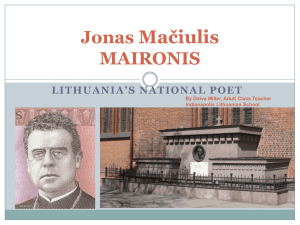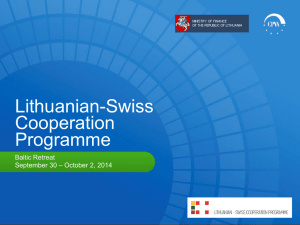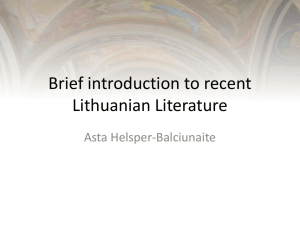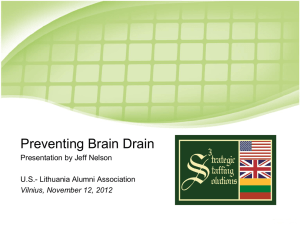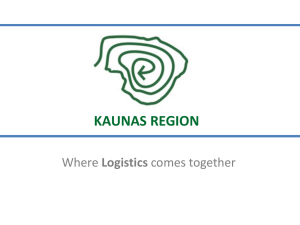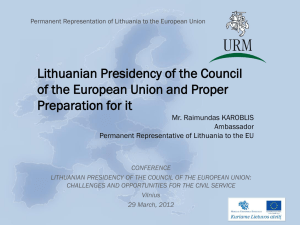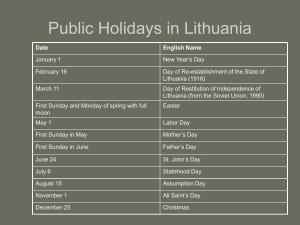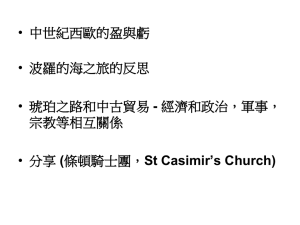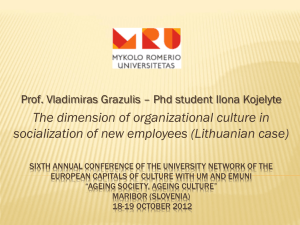Prices in Lithuania
advertisement
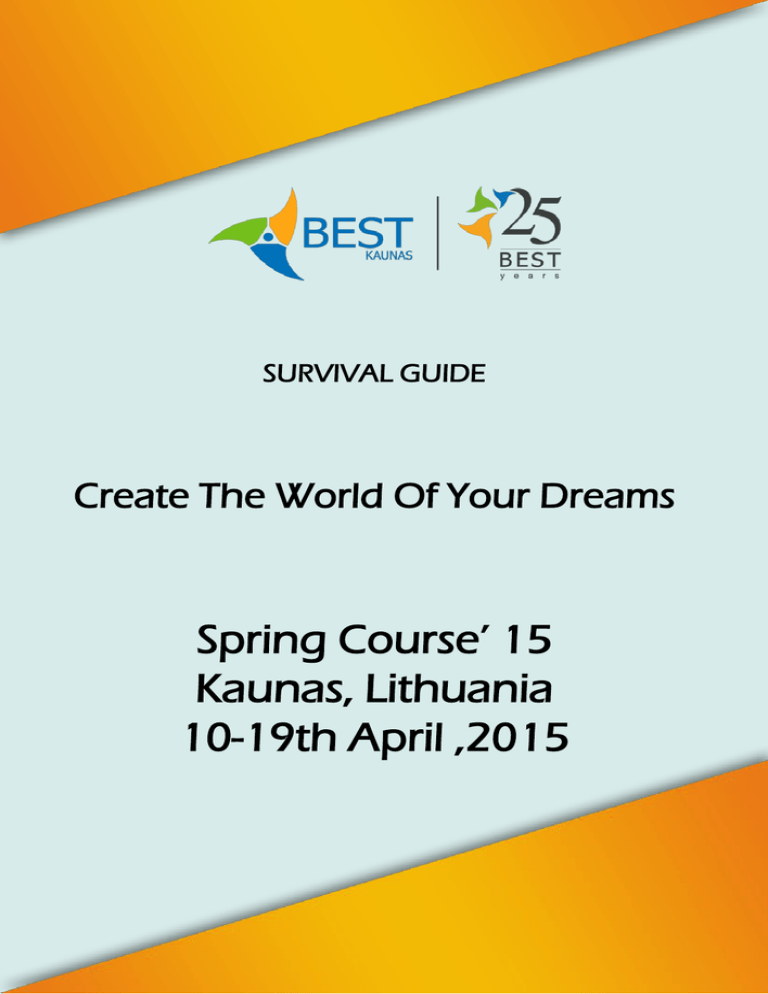
SURVIVAL GUIDE Create The World Of Your Dreams Spring Course’ 15 Kaunas, Lithuania 10-19th April ,2015 Contents Magical Lithuania.............................................................3 History .......................................................................4 Landscape..................................................................4 Language.........................................................................5 Alphabet .....................................................................5 Pronunciation .............................................................5 Some sentences..........................................................6 Numbers.....................................................................6 Culture ............................................................................7 Lithuanian Heart- Kaunas.................................................8 History........................................................................9 How to reach Kaunas.................................................10 Get around................................................................11 What to see?..............................................................11 Documentation................................................................12 Insurance, Medical treatment......................................12 Isic..............................................................................12 Prices in Lithuania............................................................13 Useful stuff......................................................................14 Time zone...................................................................14 Weather......................................................................14 Food...........................................................................14 Electricity....................................................................14 What else to bring?.....................................................15 Contacts...........................................................................16 Embassies........................................................................17 Kaunas | April 10-19, 2015 2 Magical Lithuania The State of Lithuania is an independent and democratic republic. In Lithuania the powers of the State are exercised by the Seimas (the Parliament), the President of the Republic, the Government, and the Judiciary; State Emblem: white Vytis against a red background; National Flag. The colors are yellow, green, and red; Total area: 65,300 sq. km. Population: 3 million; Ethnic Composition: Lithuanians – 83.7%, Polish – 6.6%, Russians – 5.3%, Belarusian’s – 1.3%, others – 3.1%; Religion: Roman Catholic (approximately 80% of the total population); Language: Lithuanian; Capital: Vilnius. The city was officially established in 1323. The Old Town of Vilnius is one of the largest (360 ha) and prettiest in the Eastern and Central Europe included on the UNESCO World Heritage List; Currency: Litas (EUR 1 = LTL 3.45280). Climate: oceanic/continental. Average temperature in July is +17°C, in January – -4.9°C, in October -+8°C; Local Time: GMT + 2 hours; Coastline: 99 km; International phone code: +370; Kaunas | April 10-19, 2015 3 3 History Lithuanian lands were united under MINDAUGAS in 1236; over the next century, through alliances and conquest, Lithuania extended its territory to include most of present-day Belarus and Ukraine. By the end of the 14th century Lithuania was the largest state in Europe. An alliance with Poland in 1386 led the two countries into a union through the person of a common ruler. In 1569, Lithuania and Poland formally united into a single dual state, the Polish-Lithuanian Commonwealth. This entity survived until 1795, when its remnants were partitioned by surrounding countries. Lithuania regained its independence following World War I but was annexed by the USSR in 1940 - an action never recognized by the US and many other countries. On 11 March 1990, Lithuania became the first of the Soviet republics to declare its independence, but Moscow did not recognize this proclamation until September of 1991 (following the abortive coup in Moscow). The last Russian troops withdrew in 1993. Lithuania subsequently restructured its economy for integration into Western European institutions; it joined both NATO and the EU in the spring of 2004. Landscape The Lithuanian landscape is predominantly flat, with a few low hills in the western uplands and eastern highlands. The highest point is Aukštasis at 294 meters. Lithuania has 758 rivers, more than 2 800 lakes and 99 km of the Baltic Sea coastline, which are mostly devoted to recreation and nature preservation. Forests cover just over 30% of the country. Movie about Lithuania: http://www.youtube.com/watch?v=v_baiTuFJWo Kaunas | April 10-19, 2015 4 4 Language Lithuanian (lietuvių kalba) is the official state language of Lithuania and is recognized as one of the official languages of the European Union. There are about 2.96 million native Lithuanian speakers in Lithuania and about 170,000 abroad. Lithuanian is a Baltic language, closely related to Latvian, although they are not mutually intelligible. It is written in an adapted version of the Roman script. The Lithuanian language is believed to be the most conservative living Indo-European language, retaining many features of Proto Indo-European now lost in other Indo-European languages. Alphabet A a Ą E H K P U Ž ą e h k p u ž B Ę I L R Ų C Ė Į M S Ū Č F Y N Š V D G J O T Z b ę i l r ų c ė į m s ū č f y n š v d g j o t z Pronunciation Reading Lithuanian is a bit complicated. Mostly you pronounce words as they are written. There are some exceptions, and differences with other languages: Ą – ą – pronounce like normal A, but much longer Č – č - as in “chair” E – e - as in “elephant” Ę – ę - as in “cat” Ė – ė - There is no word that begins with the letter Ė in English Y – y – as in “eagle” Į – į - as in “eagle” Š – š – as in “share” Ų – ų – as in “roof” Ū – ū – as in “roof” Ž – ž – as in “bourgeoisie” Kaunas | April 10-19, 2015 Labas Labas 5 Some sentences - Labas rytas - Good morning - Laba diena - Good afternoon - Labas vakaras - Good evening - Labanakt - Good night - Labas – Hello -Taip-Yes -Ne - No - Viso gero - Goodbye. - Prašau - Please. - Ačiū - Thank you. - Sveiki atvykę - You are welcome. - Atsipašau - Sorry. - Kiek tai kainuoja? - How much is it? - Ką tokia/toks mergina/vaikinas daro tokioje vietoje? - What´s a (girl/boy) like you doing in a place like this? - Koks tavo zodiako ženklas? - What’s your sign (of the zodiac)? - Aš braškė, valgyk mane! - I’m a strawberry, eat me!! - Aš tave myliu! - I love you! - Ar tiki meile iš pirmo žvilgsnio, ar turėčiau pro tave praeiti du kartus? Do you believe in first look love or I have to walk in front of you twice? - Lietuviškas alus yra geriausias pasaulyje! - Lithuanian beer is the BEST beer of the world. - Tu tokia graži… - You’re so beautiful... - Tu toks gražus… - You’re so handsome... Numbers Vienas - one Du – two Trys – three Keturi – four Penki – five Šeši – six Septyni – seven Aštuoni – eight Devyni – nine Dešimt – ten Kaunas | April 10-19, 2015 Vienuolika – eleven Dvylika – twelve Trylika – thirteen Keturiolika – fourteen Penkiolika – fifteen Šešiolika – sixteen Septyniolika – seventeen Aštuoniolika - eighteen Devyniolika – nineteen Dvidešimt - twenty 6 Culture The culture of Lithuania has been influenced by geography, historical events, and artistic movements. Various cultural changes occurred throughout Lithuania's transformation from a former country of the Soviet Union to an independent Baltic state. Lithuanian is Lithuania's official language, and most Lithuanians are Roman Catholics. Folk is an influential genre on Lithuanian music, literature, and film. Lithuania has a long history of folk, popular and classical musical development. Lithuanian folk music is based primarily around polyphonic music played on flutes, zithers (kanklės) and other instruments. Lithuania has a lively drama scene. Many film festivals exist, such as Kino Pavasaris and the AXX Commercial Film Festival Contest. Film tradition has emerged throughout Lithuania's occupation by the Soviets. A popular Lithuanian film classic is Velnio Nuotaka, which is based upon folk tales. A major theater in Lithuania is the Lithuanian National Drama Theater. Another theatre, the Vilnius Little Theatre, was founded by Rimas Tuminas. Vilnius Little Theatre produces Shakespeare plays and other productions. Several directors are important to Lithuania's theatre scene. Eimuntas Nekrošius is a major part of Lithuania's theatre movement and has a theatre company, Meno Fortas. Lithuania's literature is based upon folklore tradition. Song books began publishing in the sixteenth century. The first Lithuanian book was Katekizmas (Simple Words of Catechism) by Martynas Mažvydas in 1547. Lithuania is historically one of the most prestigious and successful teams in international competition, winning medals in three out of five Olympic tournaments, coming away with three consecutive bronze medals. Lithuania's art community is famous for Mikalojus Konstantinas Čiurlionis (1875– 1911). Čiurlionis was a nationally renowned musician and artist in Lithuania. His symphonic compositions, Jūra ("The sea") and Miške ("In the forest"), were the first full length pieces from a Lithuanian musician. Kaunas | April 10-19, 2015 7 7 Kaunas - the heart of Lithuania Kaunas with nearly 400 thousand inhabitants is one of the most significant cities of Lithuania. It is not only a city of old traditions, but also a large centre of business and industry. It can also lay claim to be a city of young people with over 35,000 students studying at one of the seven universities here. Meet 3000 devils in the heart of Lithuania. Enjoy Jazz Festival or Classical music during the Pazaislis music festival. Be the first to discover the bird flight from the roof of Resurrection church, feel free and be brave to try professional acrobatic flights, wake a pilot inside you. Believe in the second “religion”- basketball and shake the famous Europe basketball players by the hand. Indulge water activities like yacht regattas or water biking. That is what you can do here, in our city Kaunas. Major facts about the city Kaunas is the second biggest city in Lithuania, located in the center of the country on a confluence of two biggest country's rivers - Nemunas and Neris. In 1920-1940. Total area of the city - 15.700 ha, number of inhabitants - over 350.000. Kaunas is a huge culture center, rich in museums. There are also 26 libraries, 17 theatres, 20 folklore ensembles, various other art, sport collectives. In Kaunas work 7 universities, study 35.000 students. Every year various festivals take place: Pazaislis Music Festival, "Kaunas Jazz", musical "In Kaunas Castle", modern dance festival "Aura", modern music festival "Iš arti“. One of the most famous culture event city's birthday "Kaunas City Days", celebrated on May. Kaunas | April 10-19, 2015 8 8 History Brief history of Kaunas city First mentioned by chroniclers in 1361. To defend from crusaders attacks a brick castle was built, soon it became an important part of city's defence system. In 1408 Vytautas the Great gave Kaunas Magdeburg rights. Since then the city started to expand rapidly, grew its importance as a center of trade with West Europe and as a harbour. In 16th century were built first school, public hospital, pharmacy and until the end of the century Kaunas became one of the best formed city in the Great Duchy of Lithuania. In 1812 Napoleon army was moving across the river Nemunas. During the war city was wasted for 2 times. In 1862 first railway was built, in 1898 first electric power station started to work - all that helped to develop city's industry and trade. However further development was suspended by World War I. After russians took country's capital Vilnius, state's council and the Cabinet moved to Kaunas. When Vilnius was occupied by Poland in 1920, Kaunas became temporary capital and the most important city of Lithuania. In the years of independence Kaunas expanded greatly, number of inhbitants increased, industry prospered. In 1924 buses started to run, in 1928 plumbing was installed. Unfortunately this prospering of the city was terminated by Soviet occupation. Legend about Kaunas During a hunt, Lithuanians chased the king of Lithuanian woods – aurochs (the European bison) to the backwoods and killed it at the confluence of Nemunas and Neris. But then hunters noticed, that in between the horns of dead animal is the cross, made of wood branches. So they startleyd and sacrified the animal to the gods by burning him down. And now Kaunas stands in this place and it has the king of woods with the cross on this horns in the coat of arms. Origin of the name Nobody really knows, were do the name Kaunas comes from. There are a few versions. The primary meaning of word Kaunas could be deep, low. Root kaun- could come from Indo-European root kau – (deep and low). Last version is saying that the name Kaunas came from the family name, which can be found even in our days. Kaunas might be the ruler of local people. Sometimes name Kaunas is related to the word “Kautis” (to fight). Kaunas | April 10-19, 2015 9 How to reach Kaunas? If you are coming to Kaunas from Vilnius airport Official Vilnius airport webpage: http://www.vilnius-airport.lt/en/ FROM AIRPORT: You can choose between two possibilities: The bus No.1 goes to the train/bus station (the fare is about 2.50Lt). The train which goes to Vilnius railway station (the fare is about 2.00Lt-2.50Lt). (It is recommended to go by train, the trip would take only 7 min and the train goes directly to Vilnius railway station without stop) TO KAUNAS: You can take a bus. Bus station is across the street from Train station. The fare is 22.00 LT, with student’s card 11.00 LT. Bus runs from 5:40 and the last one goes at 22:45, you can check http://www.autobusubilietai.lt/index.php?cl=select&lang=1 You can take a train from train station where you can come with train (directly from airport) or bus . The fare is 7.00 – 10.00 LT with student’s card. Train rides from 5:20 and the last one goes at 19:20, you can check http://www.litrail.lt/wps/portal/!ut/p/c1/04_SB8K8xLLM9MSSzPy8xBz9CP0os3h3C2N_VzcPIwMDH3NHAy NTU69gPyd_wyB_Q_1wkA6zeAMcwNEAIo_DBKdQM7zyxiGG-n4e-bmp-sGpefqRlHmON1iYqYfUZaZWq4foh_prFQnR1k4eLqCABTnY5R/dl2/d1/L0lDU0lKSmhtL0lGU0FDSWlNeUNKQUtNb2tBb2chL1lBNDU0NTAtNUZ3IS83X 0c4M09FRkgyMDBMN0EwMjU1SlNOQk8xUjQ2L1drX19fMTA!/#7_G83OEFH200L7A0255JSNBO1R46/# TO OUR OFFICE FROM KAUNAS BUS STATION: Cross the and take a trolleybus number 5, 7, 13, 14 or 16, bus 39 and get out in a bus stop Pašilės. TO THE HOSTEL: You will have a possibility to enjoy the time in Kaunas living in its’ heart-center. All the information about hostel and how to get here is on their web page. So enjoy- http://r-hostel.lt/ If you are coming to Kaunas airport Official Kaunas airport webpage: https://spreadsheets.google.com/spreadsheet/ccc?key=0AlqP8YUf2_R7dDgyeUN3bTRvZjRMNTZSaEZveVF NTHc&hl=lt#gid=2 FROM AIRPORT: A city bus line No.29 serves the airport going on the route Kaunas Airport (Karmelava) – Savanoriu Ave. – Bus station – Panemune – Viciunai. Get out in Bus station stop. You can check the schedule of bus line No.29 here: http://www.marsrutai.lt/kaunas/en/#Routes/,3079,25107 TO OUR OFFICE: Cross the street and take a trolleybus number 5, 7, 13, 14 or 16, bus number 39 and get out in bus stop Pašilės. Good luck in planning your trips! Very important: let us know when and how you will arrive!!! Have questions about arriving? Feel free to ask duttea92@gmail.com Kaunas | April 10-19, 2015 10 Get around Kaunas has well developed public transport system. There are 16 trolleybus routes and 47 bus routes inside of the city. Buses and trolleybuses one time tickets can be bought in the transport (usually we use electronic tickets system, but for one time travel It is not necessary). Price for one journey is 2.4 LTL (0.70 EUR) you can buy it directly form the bus driver. For the students with ISIC (or Lithuanian student card of course ) the price is 1.2 LTL (0.35 EUR). Tickets purchased from the driver are already validated. What to see? Kaunas has several districts and sites interesting for tourists. The Old Town is the area mostly built between XIV and XVII centuries, resembling buildings in Gothic, Renaissance, and, Baroque architecture. Open spaces, parks, and places of interested are in the compact New Town as well as some different locations. A walking tour is the best way to see the Old Town of Kaunas. Kaunas | April 10-19, 2015 11 Documentation EU citizens can visit Lithuania just bringing their national ID cards. People from other countries should bring their passport and might need a visa. If this is your situation and you need some certificate to justify your assistance to event, please let us know as soon as possible. Sometimes there are problems with mail and a fax is not enough. Insurance, Medical treatment If you come from a European Union country you only need the EU sanitary card (the blue one), so if you need medical assistance, you should present your card which will give you the same entitlements as a Lithuanian Citizen - medical care free of charge and the refund of part of the cost of medicine. If you are not a citizen of the European Union but your country has signed an agreement for medical care with Lithuania (you can find out about this in the Social Security in your country), you should bring the appropriate form and act in the same way as members of the European Union. If you are not a citizen of the European Union and your country hasn’t any medical agreement with Lithuania, you will have to take out a private medical insurance. This should give you full coverage for medical care during your stay in . Lithuania. ISIC ISIC- gives students access to tens of thousands of student services and benefits worldwide. http://www.isic.org/ Kaunas | April 10-19, 2015 12 Prices in Lithuania Supermarkets LT Eur 0,5 litre beer 2.00-4.00 0.58-1.16 0,5 litre coke ~2.70 ~0.80 0,5 litre water ~1.50 ~0.43 0,5 litre vodka ~16.00-26.00 ~4.63-7.53 Chips ~2-2.50 ~0,58-0.72 1kg apples ~2.00 ~0.58 1kg bananas ~4.00 ~1.16 1kg oranges ~4.00 ~1.16 Cigarettes 8.00-10.00 2.30-2.90 0,5 litre beer 5.00-9.00 1.44-2.60 Dinner 15.00-25.00 4.00-8.00 Pizza 8.00-15.00 2.30-4.00 Deserts 5.50-10.00 1.45-3.50 A cup of coffee 2.50-6.00 0.70-1.80 A cup of tea 2.50-3.50 0.70-1.00 Coctails 7.00-12.00 2.00-5.00 Pubs or pizzerias Most shops in Lithuania open from 8:00-10:00 in the morning to 20:00-23:00 every day of the week. One big supermarket is working 24 hours per day. Alcohol can be only bought form 8.00 till 22.00. Kaunas | April 10-19, 2015 13 Useful stuff Time zone Lithuania is in the Eastern European Time Zone. Eastern European Standard Time (EET) is 2 hours ahead of Greenwich Mean Time (GMT+2). Like most states in Europe, Summer (Daylight-Saving) Time is observed in Lithuania, where the time is shifted forward by 1 hour; 3 hours ahead of Greenwich Mean Time (GMT+3). After the Summer months the time in Lithuania is shifted back by 1 hour to Eastern European Time (EET) or (GMT+2). It is one hour ahead of CET (Central European Time). Weather Lithuania's climate, which ranges between maritime and continental, is relatively mild. Average temperatures on the coast are −2.5 °C in January and 16 °C in July. In Vilnius the average temperatures are −6 °C in January and 16 °C in July. During the summer, 20 °C is common during the day while 14 °C is common at night; in the past, temperatures have reached as high as 30 or 35 °C. Some winters can be very cold. -20 °C occurs almost every winter. Winter extremes are −34 °C in coastal areas and −43 °C in the east of Lithuania. Food Lithuanians like to eat a lot and enjoy good food. Our traditional cuisine is pretty simple but has a variety of interesting dishes. Rye, potatoes, various meat, beet root, mushrooms and dairy products are often used when preparing Lithuanian food. http://ausis.gf.vu.lt/eka/food/fcont.html Electricity The voltage in Lithuania as well as the socket and plug sizes is identical to the most of European countries (220V / 50Hz). Kaunas | April 10-19, 2015 14 What else to bring? •Passport •Travel insurance •Student card (ISIC) •Photo camera and cable for it •Extra noney for food, shopping and etc. •Alcohol, to keep normal body temperature •Personal higene items •Towel •Swimsuit •Medications •Music instrument, if you have any •Comfortable clothes and shoes •For International Evening: ingredients of the national dish you're making, typical alcohol of your country, something to present your country with (a flag or something). •Costumes and other items that suits the topics of social parts •Something cosy and warm , because the weather in Lithuania is unpredictable. •And the most important thing, we need is... YOU with your good mood and will to work hard and party harder! Kaunas | April 10-19, 2015 15 Contacts: If you have any questions, do not hesitate to contact us. Gilvilė Stankevičiūtė - Main Organiser Phone: +3706 2657341 E-mail: gilvile.stankeviciute@BEST.eu.org Ingrida Pivoriūnaitė - Participant Responsible Phone: +37060011642 E-mail: ingrida.pivoriunaite@BEST.eu.org Emergency number: 112 Fire station: 011 Police: 022 Ambulance: 033 Kaunas | April 10-19, 2015 16 Embassies EMBASSIES 1. Embassy of Austria Adress: Gaono g. 6, LT-01131, Vilnius Tel: (370 5) 266 05 80, fax (370 5) 279 13 63 Mail: wilna-ob @ bmeia.gv.at 2. Embassy of Belgium Adress: Kalinausko g. 2B, LT-03107, Vilnius Tel: (370 5) 266 08 20, fax (370 5) 212 64 44 Mail: vilnius @ diplobel.fed.be 3. Embassy of Bulgaria Adress: Pylimo 8/ Palangos 2, 01118, Vilnius Tel: (370 5) 249 92 74, fax(370 5) 261 91 74 Mail: vilnius @ bgembassy.lt 4. Embassy of Czech Republic Adress: Birutės g. 16, LT-08117, Vilnius Tel: (5) 266 10 40, (5) 266 10 41, fax (5) 266 10 66 Mail: vilnius @ embassy.mzv.cz 5. Embassy of Denmark Adress: T. Kosciuškos g. 36, LT-01100, Vilnius Tel: (370 5) 264 87 60, fax (370 5) 231 23 00 Mail: vnoamb @ um.dk 6. Embassy of Estonia Adress: A. Mickevičiaus g. 4 A, LT-08119, Vilnius Tel: (370 5) 278 02 00, fax (370 5) 278 02 01 Mail: sekretar @ estemb.lt 7. Embassy of Finland Adress: Klaipėdos g. 6, LT-01117, Vilnius Tel: (370 5) 212 16 21, fax (370 5) 212 24 41 Mail: sanomat.vil @ formin.fi 8. Embassy of France Adress: Švarco g. 1, LT-01131, Vilnius Tel: (370 5) 212 29 79, fax (370 5) 212 42 11 Mail: ambafrance.vilnius @ diplomatie.gouv.fr 9. Embassy of Germany Adress: Z. Sierakausko g. 24/8, LT-03105, Vilnius Tel: (370 5) 210 64 00, fax (370 5) 210 64 46 Mail: germ.emb @ takas.lt 10. Embassy of Greece Adress: Didžioji 33/Rūdininkų 2, LT-01128, Vilnius Tel: (370 5) 261 05 26, fax (370 5) 261 05 36 Mail: embassy @ grembvil.w3.lt 11. Embassy of Hungary Adress: Jogailos g. 4, LT-01116, Vilnius Tel: (370 5) 269 00 38, faksas (370 5) 269 00 39 Mail: office @ vengrijosambasada.lt Kaunas | April 10-19, 2015 12.Embassy of Italy Adress: Universiteto g. 4, LT-2001, Vilnius Tel: (370 5) 212 06 20, faksas (370 5) 212 04 05 Mail: ambasciata @ ambitvilnius.lt,visti 13.Embassy of Ireland Adress: Gedimino pr. 1, LT-01103, Vilnius Tel: + 370 5 2629460 Mail: vilniusembassy @ dfa.ie 14.Embassy of Latvia Adress: M.K. Čiurlionio g. 76, LT-03100, Vilnius Tel: (370 5) 213 12 60, fax (370 5) 213 11 30 Mail: embassy.lithuania @ mfa.gov.lv 15.Embassy of Norway Adress: K. Kalinausko g. 24, LT-03107, Vilnius Tel: (370 5) 261 00 00,fax (370 5) 261 01 00 Mail: emb.vilnius @ mfa.no 16.Embassy of Portugal Adress: Gedimino pr. 5, LT-01103, Vilnius Tel: (370 5) 262 05 11, fax(370 5) 262 05 03 Mail: embport @ get2net.dk 17.Embassy of Poland Adress: Smėlio g. 20 A, LT-10323, Vilnius Tel: (370 5) 270 90 01, fax (370 5) 270 90 07 Mail: ambpol @ tdd.lt 18.Embassy of Russia Adress: Latvių g. 53/54, LT-08113, Vilnius Tel: (370 5) 272 17 63, fax (370 5) 272 38 77 Mail: post @ rusemb.lt 19.Embassy of Slovakia Adress: Smilšu iela 8, LV 1050, Riga Tel: (371) 781 42 80, fax (371) 781 42 90 Mail: embassy @ riga.mfa.sk 20.Embassy of Spain Adress: Algirdo g. 4, LT-03220, Vilnius Tel: (370 5) 231 39 61,fax (370 5) 231 39 62 Mail: emb.vilnius @ mae.es 21.Embassy of Sweden Adress: Didžioji g. 16, LT-01128, Vilnius Tel: (370 5) 268 50 10,fax(370 5) 268 50 30 Mail: ambassaden.vilnius @ foreign.ministry.se 22.Embassy of United Kingdom Adress: Antakalnio g. 2, LT-10308, Vilnius Tel: (370 5) 246 29 00, fax(370 5) 246 29 01 Mail: be-vilnius @ britain.lt 17
